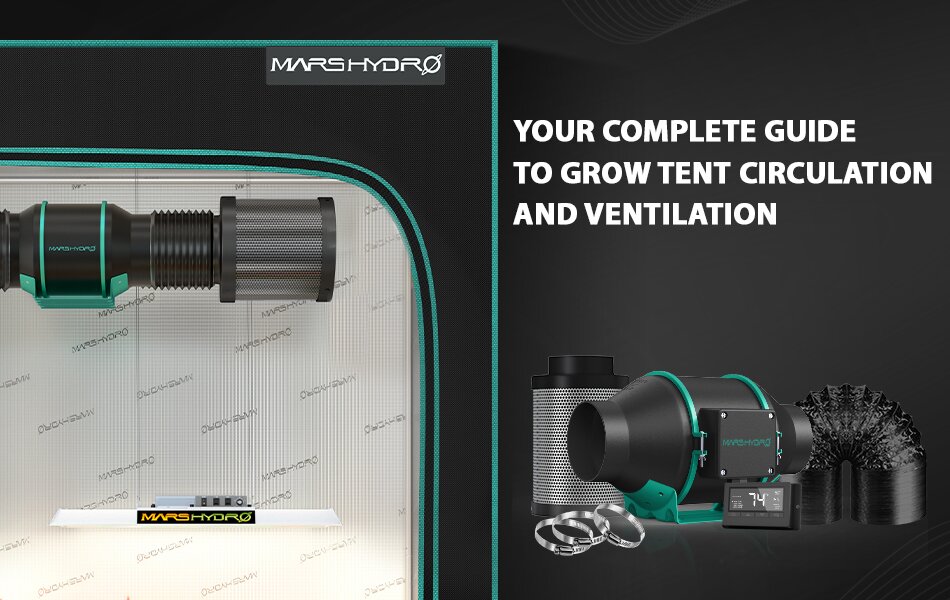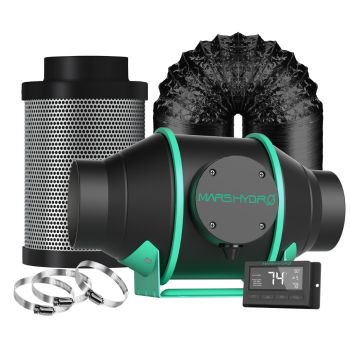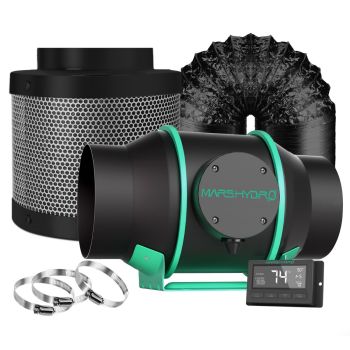
Air is crucial to the survival of plants. Green plants need air for two primary reasons - to produce their food and to break down these food substances into usable energy. Using their stomata, plants take in carbon dioxide and release oxygen during photosynthesis. The natural wind also forces plants to grow stronger fibers that can withstand the strong force of the breeze.
The natural environment is designed to meet all the air requirements of outdoor plants. Indoor plants do not have this luxury—they have limited access to natural air and may struggle to build robust fiber tissues because of non-existent strong winds. That is why experts recommend that growers set up their grow tents to ensure optimal air circulation and ventilation, replicating nature’s growing conditions as much as possible.
This guide discusses the grow room ventilation and air circulation system, its importance, its requirements, and how you can set up your grow room to ensure optimal airflow.
Why Is Optimal Grow Tent Circulation and Ventilation Essential?

As mentioned earlier, your indoor plants’ health largely depends on the air quality. Here are a few reasons you must set up your grow room to ensure optimal air circulation and ventilation.
1. Maintain the perfect carbon dioxide levels.
The right circulation and ventilation system helps to replenish the carbon dioxide by ensuring cool fresh air (with high amounts of carbon dioxide) goes in as the used oxygen goes out.
2. Maintains the right temperature and humidity levels.
Unlike outdoor plants with access to natural sunlight and regular winds, plants in a grow room are subjected to still light and air. Proper air circulation and ventilation expels excess heat and moisture from the still air. Your plants stay cool and absorb water efficiently.
3. Helps strengthen the stems of your plants.
The closest you can get to the swaying effects of the natural wind and the resultant plant strength is to set up excellent air circulation and ventilation systems. It facilitates straight upward growth, ensuring your plants can bear as many fruits or seeds in the future.
4. Protection from pests and diseases.
Plant diseases and pets thrive in areas with still or moist air. For example, fungus gnats, spider mites, powdery mildew, and mold are common in cold or moist areas. The only way to make your grow room inhabitable for these foreign elements is to keep it dry and breezy.
What Do You Need To Set Up A Ventilation System For Your Grow Room?
A grow room ventilation system comprises many vital components working together to create the best growing conditions for the plants. We have identified some of these components below:
1. Oscillating Fans
As the name suggests, oscillating fans help to circulate air effectively in your grow room, ensuring a sufficient amount of air gets to every corner of the space. They are easy to set up and work efficiently to improve ventilation.
2. Inline Duct Fans
Inline duct fans or exhaust fans expel hot and humid air from the grow area, thereby regulating the internal temperature. In some ventilation systems, inline duct fans also serve as a vacuum bringing in the fresh air with large amounts of carbon dioxide.
3. Duct Tubes
Duct tubes work with inline duct fans, serving as a channel or route through which the fan expels the duct air from the grow space. Most duct tubes are made of aluminum, but they can be multilayered for additional protection and durability.
4. Carbon Filter
Carbon filters or carbon scrubbers absorb the smell of plants from the escaping air, keeping it away from your immediate environment. If you are growing plants with strong aromas, including carbon filters in your ventilation system will keep your air clean and odorless.
5. Silencer
You may consider silencers if your exhaust fans and oscillating fans are noisy. They provide extra stealth, ensuring the people around are not disturbed by the annoying loud whines from the fans.
Knowing what you need for your ventilation system is half the job. The other half is finding them in the market. At Mars Hydro, we offer the best quality ventilation system components, including carbon filters, inline duct fans, and others. Our inline duct fan and carbon filter combo quietly ventilate your indoor grow rooms while eliminating odors.
What Factors Should You Consider When Setting Up A Grow Tent Ventilation System?
Getting the best out of your ventilation system starts right from the setup. This section outlines the important factors to consider to build an optimal ventilation system for your grow room.
1. Decide between active or passive air intake.
A passive air intake ventilation system is designed to bring in new air through a dedicated hole. In contrast, the active intake ventilation system relies on two different fans, one pushing air out and the other drawing air in. Your choice between active and passive ventilation will inform the components you will pick up from the market to set up your ventilation system.
2. Know your grow room’s CFM rating.
The cubic feet per minute (CFM) of your grow room is the amount of air your fan can move per minute. It is determined by multiplying the height of your grow room by its width and length. The ideal fan should have a CFM rating higher than the cubic feet of your grow room.
3. Go for the right fan/duct size.
There are different sizes of inline duct fans out there, including the 4”, 6”, and 8.” The correct size will depend on the size of your grow room, but most standard-sized grow rooms will be fine with the 6” fans/ducts.
4. Choose a suitable ducting material.
As mentioned earlier, duct tubes are made of different materials. Experts often recommend ducts made with flexible aluminum for your grow rooms. Aluminum as a ducting material is lightweight, easy to work with, and affordable. Consider insulated ducts if you prefer higher ventilation efficiency and budget permits.
5. Set a budget.
The flexibility of ventilation systems means you can achieve the same result using different components. Having a budget and sticking with it guides your choice of components you use throughout the process.
To Round Up…
Growing plants in a contained area hinders proper airflow. Oxygen replaces carbon dioxide faster because the latter gets depleted more quickly. An adequate grow room ventilation ensures fresh air enters and stale air escapes from the grow area efficiently. This is the only way to keep your plants healthy.
Check out the Mars Hydro catalog to shop for your grow room air circulation and ventilation system.








